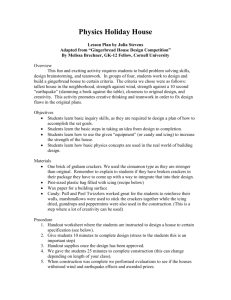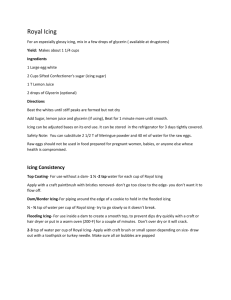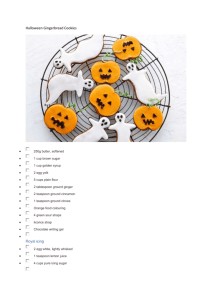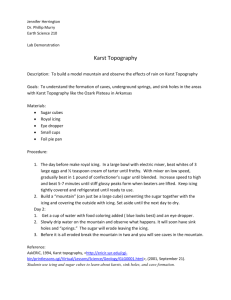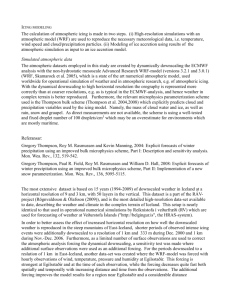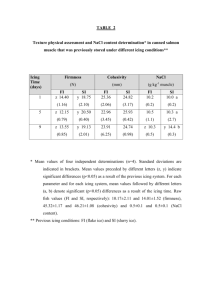P1(15)_Heimo_Switzerland
advertisement
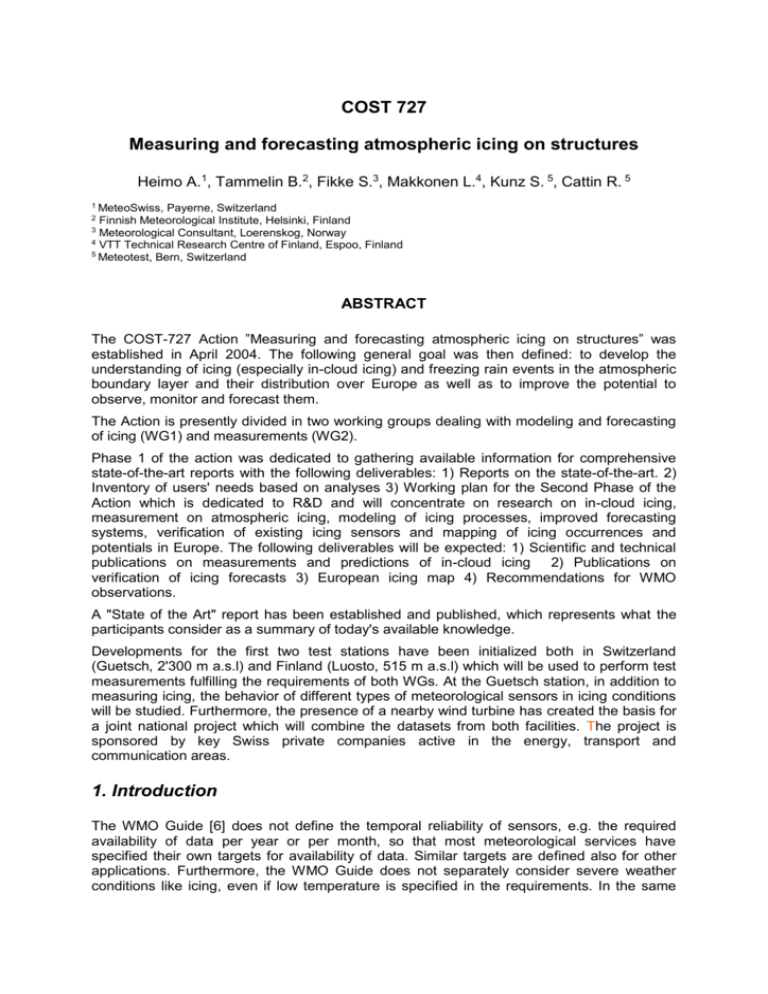
COST 727 Measuring and forecasting atmospheric icing on structures Heimo A.1, Tammelin B.2, Fikke S.3, Makkonen L.4, Kunz S. 5, Cattin R. 5 1 MeteoSwiss, Payerne, Switzerland Finnish Meteorological Institute, Helsinki, Finland 3 Meteorological Consultant, Loerenskog, Norway 4 VTT Technical Research Centre of Finland, Espoo, Finland 5 Meteotest, Bern, Switzerland 2 ABSTRACT The COST-727 Action ”Measuring and forecasting atmospheric icing on structures” was established in April 2004. The following general goal was then defined: to develop the understanding of icing (especially in-cloud icing) and freezing rain events in the atmospheric boundary layer and their distribution over Europe as well as to improve the potential to observe, monitor and forecast them. The Action is presently divided in two working groups dealing with modeling and forecasting of icing (WG1) and measurements (WG2). Phase 1 of the action was dedicated to gathering available information for comprehensive state-of-the-art reports with the following deliverables: 1) Reports on the state-of-the-art. 2) Inventory of users' needs based on analyses 3) Working plan for the Second Phase of the Action which is dedicated to R&D and will concentrate on research on in-cloud icing, measurement on atmospheric icing, modeling of icing processes, improved forecasting systems, verification of existing icing sensors and mapping of icing occurrences and potentials in Europe. The following deliverables will be expected: 1) Scientific and technical publications on measurements and predictions of in-cloud icing 2) Publications on verification of icing forecasts 3) European icing map 4) Recommendations for WMO observations. A "State of the Art" report has been established and published, which represents what the participants consider as a summary of today's available knowledge. Developments for the first two test stations have been initialized both in Switzerland (Guetsch, 2'300 m a.s.l) and Finland (Luosto, 515 m a.s.l) which will be used to perform test measurements fulfilling the requirements of both WGs. At the Guetsch station, in addition to measuring icing, the behavior of different types of meteorological sensors in icing conditions will be studied. Furthermore, the presence of a nearby wind turbine has created the basis for a joint national project which will combine the datasets from both facilities. The project is sponsored by key Swiss private companies active in the energy, transport and communication areas. 1. Introduction The WMO Guide [6] does not define the temporal reliability of sensors, e.g. the required availability of data per year or per month, so that most meteorological services have specified their own targets for availability of data. Similar targets are defined also for other applications. Furthermore, the WMO Guide does not separately consider severe weather conditions like icing, even if low temperature is specified in the requirements. In the same way, the manufacturers typically specify their instruments’ performance for severe weather conditions by taking into account low temperature (for instance operating range: -40C… + 50C), but not icing. Presently, icing events are defined as periods of time where the temperature is below 0°C and the relative humidity is above 95%, a very simplified approach. Usually low air temperature is not a major problem for meteorological observations: for many sensors, this is taken into account e.g. by using shaft heating for anemometers with rotating parts (at small and/or mobile automatic stations, the power supply may not be sufficient even for shaft heating). The COST-727 Action1 ”Measuring and forecasting atmospheric icing on structures” was established in April 2004 [1] in order to attempt to solve the problems mentioned above. It is presently divided in two Working Groups (WG) dealing with modelling/forecasting of icing (WG1) and measurements (WG2). Phase I of the action was dedicated to gathering available information for comprehensive state-of-the-art reports with the following deliverables: Reports on the state-of-the-art Inventory of users' needs based on analyses Working plan for the Second Phase of the Action Phase II of the Action is dedicated to R&D and will concentrate on research on in-cloud icing, measurement on atmospheric icing, modelling of icing processes, improved forecasting systems, verification of existing icing sensors and mapping of icing occurrences and potentials in Europe. The following deliverables will be expected: Scientific and technical publications on measurements and predictions of in-cloud icing Publications on verification of icing forecasts European icing map Recommendations for WMO observations and further work. The present paper deals with the result of WG2 concerning measurements of icing as well as measurements performed under icing conditions. A summary of the State-of-the-art report from the two-year preparatory phase will be presented below together with some description of the Swiss activities in that field performed at the new MeteoSwiss test station at the Guetsch which is collocated with an operational wind turbine. 2. Icing conditions: definitions, requirements and recommendations The word icing is used to describe the process of ice or snow growth on ground based structures exposed to the atmosphere (roads and airstrips not included). The potential for icing of structures is an important design parameter in the sectors of, e.g., building industry (TV towers and ski lifts), energy distribution, maritime activities, aviation conditions on the ground and meteorological observations. It has also recently become a relevant issue in activities related to wind energy production, where the icing of blades and control wind gauges significantly reduces the power production and causes a severe environmental safety 1 COST Action 727 is supported by 11 European countries: Austria, Bulgaria, Czech Republic, Finland, Germany, Hungary, Norway, Spain, Sweden, Switzerland, United Kingdom and Kaganawa Institute of Technology, Japan. problem. Furthermore, as human activities are increasingly extending to cold climate regions, there is also a need to increase robust meteorological measurements under cold climate conditions. Freezing rain may be a significant factor at some sites. Freezing rain is a meteorological parameter which is routinely observed as occurrences by national meteorological networks. In recent years there has also been considerable research effort by electricity companies in the study of ice and wet-snow accretion on overhead transmission lines. This research has also involved the participation of several European research centers and institutes. In many cases the most severe form of icing is in-cloud icing. It occurs when super-cooled cloud droplets collide with cold surface. As the intensity of ice accretion is strongly related to wind speed, it is a severe problem especially at elevated sites such as high towers and structures built in mountains or upon hills. There are some theories available on in-cloud ice accretion upon structures, but so far there are not enough statistics or measurements available to be able to predict icing and impacts of ice accretion or to assess the geographical distribution of ice accretion intensity. Very sophisticated icing models based on spectrum of particle size, mass of particles and their thermodynamic state, and description of the airflow are available. However, there is little information on input parameters required for the modeling of ice accretion as well as under which exact atmospheric conditions in-cloud icing occurs. The State-of-the-art report from the two-year preparatory phase of COST Action 727 “Measuring and forecasting atmospheric icing on structures” is presented under the following topics with an emphasis on measurements: Definition of icing: WG 2 recommends adopting the ISO12494 standard [4]. Past and present activities: International projects such as WMO/CIMO Instrument Intercomparison [2], EUMETNET SWS I and II projects [5], EU/WECO and NEW ICETOOLS projects as well as entities such IEC/CENELEC, ISO, IWAIS are shortly presented. Standards: Prevailing standards in use (ISO [4], IEC and WMO [6]) dedicated to icing on structures and icing measurements are shortly presented. Measurements under icing conditions: As the WMO has presently no specific recommendations for measurements performed in harsh conditions, e.g. icing, a set of recommendations is presented concerning classification of sites and classification of sensors depending on severity of icing and the site climatic environment. Requirements and availability of ice detectors: It is shown that requirements on ice detectors are dependent of the user’s requirement (wind energy, power lines, meteorology etc.) and on the application. Installation procedures are presented, depending on users requirements together with validation and verification processes. Examples of existing data and experiences with existing ice detectors: A number of available long term experiments are presented concerning icing measurements and characterization of icing sensors. These activities have taken place in numerous countries like Finland, Germany, Slovak Rep., Norway, Czech Rep., UK, and indirectly from France, Switzerland, Sweden, Bulgaria, etc. Recommendations for future activities: The establishment of test centres within the COST-727 Action (Phase II) have a temporary character. It is recommended that long-term international calibration stations are established with a sufficient financial support for continuous operation. These calibration centres are to be recognized for delivering approved certificates for icing detectors and ice-free sensors. The results of future synoptic icing measurements will serve as a foundation for icing frequency maps, calculation of wind energy production losses and design loads due to ice build-up as well as a background for icing forecasts. Long term synoptic icing measurements have historically been hindered by a sheer lack of suitable sensors (and knowledge). Consequently, an inventory and analysis of measurements made and of today’s icing sensors has been carried out within COST 727. 3. The Swiss project 3.1 Goals The project "Alpine Test Site Guetsch: Meteorological measurements and wind turbine performance analysis" will expand the knowledge base on atmospheric icing specifically in the Alps. It fits into an international comparison network and will allow for comprehensive testing and improvement of monitoring equipment. The project covers mainly the objectives of Working Group 2 of the COST 727 action. Some topics cover as well issues of Working Group 1: 1) Evaluate ice detecting devices in the real alpine atmospheric conditions by comparison of existing commercial and newly developed ice detectors of various types in the winter periods 2005/6, 2006/7 and 2007/2008. This is achieved by upgrading the existing meteorological station Guetsch (displayed in Picture 1) as test station for ice detector testing. Guetsch is a synoptic station of MeteoSwiss developed in 2003/2004 in the context of the new meteorological network SwissMetNet (more details to be found in Poster P1-17). It is already equipped with a large variety of high quality sensors and will allow to monitor precisely the atmospheric conditions. A number of icing sensors (market available and prototypes) to detect periods and amount of ice accretion will be installed and monitored. The sensors work on very different physical principles as weighting of the ice mass, change of reflectivity of the surface on which ice accretion occurs, IR detection of ice films, etc.. The evaluation of the experimental data will give feedbacks on the suitability of the different principles under real conditions and for different applications and purposes. The combination of a comprehensive meteorological monitoring on the site and the detection of icing will help to establish a better understanding and modelling of the icing processes. This will allow to develop the algorithms to calculate and map the risk of icing in the alpine space. Picture 1: View of the new mountain test station of MeteoSwiss at the Guetsch (2300 m a.s.l. The nearby E-40 wind turbine is seen at the back. 2) Monitor the behavior of the wind power generator Enercon E-40 installed at the Gütsch site in icing conditions by EWU (Elektrizitaetswerk Urseren). As the EWU plans to expand the power generation and as this station is the highest production and test site for large wind generators in the alps, the results will be representative for the whole alpine space. Comprehensive monitoring of the icing on the highest located large wind turbine will allow to better understand demands for standard ice sensors to be integrated on turbines. Automatic icing sensors, indirect measurements (loss of power production, unbalance of the rotor) and optical control by cameras and image processing will be combined. 3) Set up tools and recommendations for estimating icing conditions at standard meteorological stations not equiped with ice detectors. 4) Set up guidance in meteorological measurements and modelling to fulfil the needs of the industry (traffic, power transmission, wind energy) – especially for alpine sites in Switzerland. The main topic of the research plan is to carry out a comprehensive experimental study under the specific conditions of one of the most populated high mountain areas in the world the Alps. However, if a proper analysis of an icing event is to be made, it is not sufficient to merely measure the occurrence of icing. On top of standard meteorological parameters, including solar radiation, at least two additional governing background parameters are needed: a) the liquid water content of the air and b) the droplet size. Such sensors are under development and will be presented. 3.2 Preliminary results The project's first winter period 2005/6 was designated as a test period in order to establish and stabilize the data acquisition as well as to install first measurements at the meteorological station and at the wind turbine. The following steps have been achieved: Picture 2: Icing at the blade of the operational E-40 wind turbine recorded automatically by a webcam mounted at the nacelle. The meteorological test station may be spotted on the right side of the picture nearby the 2 wind masts. 1) All incoming data from the meteorological station and the wind turbine are synchronized and stored into a dedicated data base which allows for the analysis and correlation of the meteorological conditions and the wind turbine performance during icing events. 2) A web cam is mounted at the nacelle of the wind turbine. By use of motion-detection, a picture of a passing rotor blade is taken every 15 minutes. With this procedure, it is possible to install the camera on the motionless part of the turbine which results in a very good camera performance. The test runs during winter 05/06 already provided a large number of high quality images which, together with the operational data, allow the investigation of icing on the rotor blades and the performance of the blade heating (Picture 2). 3) As the wind turbine is located close to ski slopes, ice throw is an important safety issue. Therefore, the area around the wind turbine was inspected after every icing event for ice fragments that had fallen off the blades. Distance from and direction relatively to the turbine as well as size and weight of the recovered fragments were mapped and, together with photos, collected in a data base. During winter 2005/6, over 100 ice fragments with a maximum length of more than 40 cm and weight up to 850 g could be recorded in distances up to 92 m from the wind turbine (Picture 3). Picture 3: Ice throw of the E-40 wind turbine. 4. Conclusion Icing environments set special requirements for sensors. Accurate meteorological measurements under cold and icing conditions are required for various applications such as aviation, transportation, emergency services, tourism industry, meteorological observations, wind energy production, etc. Instruments performing measurements (such as humidity, temperature, wind speed, wind direction, precipitation, radiation, etc.) in cold climate environments have to be properly heated to maintain their accuracy under icing conditions. Today, there are several types of ice-free sensors available on the market. Some of them will not fulfill the requirements of the World Meteorological Organization (WMO) for accuracy and availability when operated under icing conditions, especially at mountainous sites, but also at sites like airports, road stations e.g. in northern Europe. The practical requirements on accurate operation of sensors are even more demanding for many applications other than for meteorological synoptic purposes. The accuracy of the surface measurements of various meteorological variables is essential for meteorological services, researchers in climatology, aeronautical meteorology, etc. It is therefore essential to characterize the effects of ice accretion on the sensors and, when possible, to prevent it. The COST-727 Action was designed to offer a tentative answer for all or part of these problems. In particular, the availability of both a meteorological test site and a wind turbine at an Alpine location offers a unique opportunity for studying the impact of icing on meteorological stations and energy provider equipment. Therefore, the data collected during winter 2005/6 at the Guetsch test facility allows for the investigation of several case studies of the wind turbine's performance under icing conditions in relationship with the meteorological information. During summer 2006 the meteorological test station has been extended with various ice detectors for instruments’ evaluation and inter-comparison. Data acquisition at the wind turbine will also be expanded. References 1. COST-727 Action: Memorandum of Understanding 2. WMO Wind Instrument Intercomparison, Mont Aigoual, France 1992-1993: Final report by P. Gregoire and G. Oualid. Instruments and observing methods report; no. 62 Technical document (WMO); no. 85 3. B. Tammelin and al Improvement of Severe Weather Measurements and Sensors – EUMETNET SWS II Project. FMI reports 2004:3 4. ISO 12494: “Atmospheric icing of structures”. ISO/TC 98/SC 3, 2000-07-20 5. Tammelin, B., Heimo, A., Leroy, M., Rast, J., Säntti, K., Bellevaux, C., Dal Cin, B., Musa, M. and Peltomaa, A., 2004. Improvement of severe weather measurements and sensors – EUMETNET SWS project, Final Report. Reports 2004:3, Finnish Meteorological Institute, Helsinki. 101 p. 6. World Meteorological Organisation 1996. Guide to Meteorological Instruments and Methods of Observations. WMO-No. 8. Secretariat of the World Meteorological Organization, Geneva, Switzerland.
